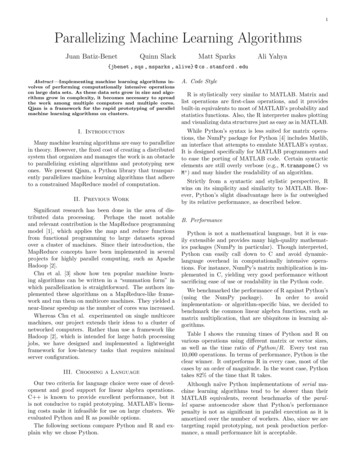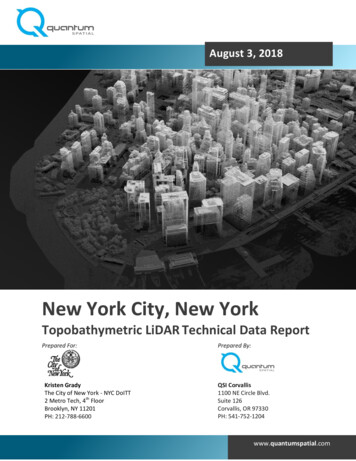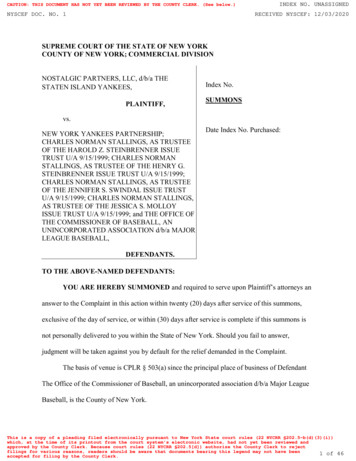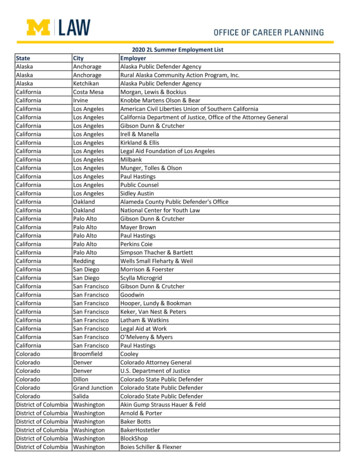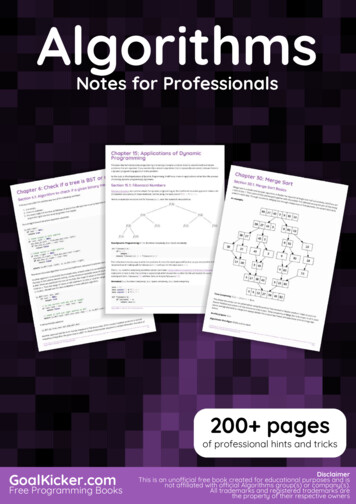
Transcription
Algorithms for Nonlinear Models inComputational Financeand theirObject-oriented ImplementationbyRobert BuA dissertation submitted in partial ful llment of therequirements for the degree of Doctor of PhilosophyDepartment of Computer ScienceGraduate School of Arts and SciencesNew York UniversitySeptember 1999Approved:Marco Avellaneda
c Robert BuAll rights reserved 1999
AcknowledgmentI have traded options only once in my life, almost a decade ago. Having learned aboutoptions from newspaper diagrams that proliferated after the Deutsche Terminb orse wasset up, my initial investment of 5000 DEM shriveled to 1500 DEM in a matter of days.A few years ago, I returned to the subject as a computer science student at NYU. Tocreate risk management tools appealed as a safer road to the holy grail of high nance,and one for which I was well equipped, given my experience and education. Havingnished this thesis, I am encouraged to promise that eventually, I'm going to use theinsight I gained over the last few years to make those 3500 DEM (and some more) back!I would like to thank my advisor, Prof. Marco Avellaneda, for accepting me as thenancial greenhorn I was and guiding me to a stage where I can navigate Wall Streetwith con dence. Besides teaching me the intricacies of UVM and dynamic programming,Marco has always allowed me to contribute from the perspective of a computer scientist.I thank Prof. Robert Kohn and Prof. Bud Mishra, Prof. Jonathan Goodman andProf. Michael Overton for serving as members of my committee.I thank Prof. Arthur Goldberg for funding me over the last two years. Readers of thelast chapter of this thesis will notice that our work on Internet performance issues hasinspired the direction of my research quite a bit.iv
ContentsAcknowledgmentiv1 Introduction11.11.21.31.41.51.6Uncertain Volatility Scenarios and Exotic OptionsVolatility Shock Scenarios . . . . . . . . . . . . . .Object-Oriented Implementation . . . . . . . . . .Client-Server Computing on the Web . . . . . . . .Related Work . . . . . . . . . . . . . . . . . . . . .How to Best Read this Thesis . . . . . . . . . . . .356799I Computational Finance: Theory112 Notation and Basic De nitions123 Continuous Time Finance142.1 Linear Algebra . . . . . . . . . . . . . . . . . . . . . . . . . . . . . . . . . 122.2 Probability and Stochastic Processes . . . . . . . . . . . . . . . . . . . . . 122.3 Portfolios and Partial Portfolios . . . . . . . . . . . . . . . . . . . . . . . . 133.1 Deterministic Volatility . . . . . . . . . . . . . .3.1.1 One-Factor Black-Scholes Analysis . . . .3.1.2 Interest Rate Models . . . . . . . . . . . .3.2 Stochastic Volatility . . . . . . . . . . . . . . . .3.2.1 Tradable and Nontradable Factors . . . .3.2.2 Some Concrete One-dimensional Models .4 Scenario-based Evaluation and Uncertainty4.1 Preliminaries . . . . . . . . . . . . .4.2 The Worst-case Volatility Scenario .4.2.1 Worst-case Pricing . . . . . .4.2.2 The Optimal Hedge Portfolio4.2.3 Calibration . . . . . . . . . .v.141416202021252528293132
4.3 Scenarios and Nonlinearity . . . . . . . . . . . . . . . . . . . . . . . . . . 34II Algorithms for Nonlinear Models365 A Lattice Framework375.1 Multi-lattice Dynamic Programming . . . . . . . . . .5.1.1 Data Structures . . . . . . . . . . . . . . . . . .5.1.2 Data ow for Explicit Methods . . . . . . . . .5.1.3 Data ow for Mixed Explicit/Implicit Methods5.2 Numerical Issues . . . . . . . . . . . . . . . . . . . . .6 Algorithms for Barrier Options6.1 The Hierarchy of PDEs6.1.1 Construction . .6.1.2 Complexity . . .6.2 Performance Results . .6.2.1 Convergence . .6.2.2 Combinatorics .7 Algorithms for American Options.7.1 Early Exercise Combinations . . . . . . . . . . .7.1.1 Long and Short Positions . . . . . . . . .7.1.2 Best Worst-case Evaluation Formalized .7.2 Speedup Techniques . . . . . . . . . . . . . . . .7.2.1 Maintaining the Corridor of Uncertainty .7.2.2 Collapsing the Corridor of Uncertainty . .7.2.3 Other Issues . . . . . . . . . . . . . . . . .7.3 Performance Results . . . . . . . . . . . . . . . .7.3.1 Complexity . . . . . . . . . . . . . . . . .7.3.2 A Mass Test . . . . . . . . . . . . . . . .7.4 American Options and Calibration . . . . . . . 111121
8 Exotic Volatility Scenarios8.1 Volatility Shocks for Portfolios of Vanilla Options .8.1.1 Worst-case Volatility Shocks . . . . . . . . .8.1.2 Experimental Results . . . . . . . . . . . .8.2 Volatility Shocks and Exotic Options . . . . . . . .122122124135138III Object-oriented Implementation1459 The Architecture of MtgLib1469.1 The Class Hierarchy External .9.1.1 Instruments . . . . . . . .9.1.2 Portfolios . . . . . . . . .9.1.3 Models . . . . . . . . . .9.1.4 Model coeÆcients . . . .9.1.5 Scenarios . . . . . . . . .9.1.6 Numerical methods . . . .9.1.7 Evaluaters . . . . . . . . .9.2 The Class Hierarchy Internal .9.2.1 Compute Engines . . . . .9.2.2 Other Groups of Classes .10 Towards Web-based Applications.10.1 Example 1: a Client/Server UVM Pricer . .10.2 Example 2: Remote Calibration Sketched .10.2.1 Theoretical Foundations . . . . . . .10.2.2 Extensions to MtgLib . . . . . . . .10.2.3 Architecture . . . . . . . . . . . . 1911 Conclusion227Bibliography228vii
List of Figures1.1 Our achievements and vision in a nutshell . . . . . . . . . . . . . . . . . .1.2 Progressing from a general view on evaluation to the concrete method forthe concrete model . . . . . . . . . . . . . . . . . . . . . . . . . . . . . . .4.1 Both scenario and portfolio are required components when model coeÆcients are instantiated . . . . . . . . . . . . . . . . . . . . . . . . . . . . .4.2 Scenario and portfolio components for worst-case volatility scenarios . . .5.1 The nal payo with and without the barrier option . . . . . . . . . . . .5.2 Data ow for explicit one-level nite di erencing in the continuation region5.3 Data ow for mixed explicit/implicit one-level nite di erencing in the continuation region . . . . . . . . . . . . . . . . . . . . . . . . . . . . . . . . .5.4 Discretizing space while preserving the von Neumann condition . . . . . .5.5 The explicit forward Euler scheme to compute the worst-case value . . . .6.1 Two paths taken by the underlying asset, with one path crossing the barrier6.2 A portfolio consisting of four options and its upper and lower extensions .6.3 The extension hierarchy created by a portfolio of four options . . . . . . .6.4 Finding the extension hierarchy amounts to computing a closure . . . . .6.5 Solving the worst-case pricing problem requires solving subordinate worstcase problems in the right order . . . . . . . . . . . . . . . . . . . . . . . .6.6 A portfolio consisting of four double-barrier options . . . . . . . . . . . .6.7 The extension hierarchy created by a portfolio of four double-barrier options6.8 The induction case for the upper bound for the extension hierarchy . . . .6.9 Prices for a double barrier call option . . . . . . . . . . . . . . . . . . . .6.10 A portfolio of four down-and-out 30-day at-the-money puts . . . . . . . .6.11 Results for a portfolio of four down-and-out at-the-money puts . . . . . .6.12 A portfolio of two 30-day barrier options and four 30-day vanilla options .6.13 Worst-case prices for a double-barrier option, a single-barrier option andthree traded vanillas . . . . . . . . . . . . . . . . . . . . . . . . . . . . . .6.14 A portfolio of four down-and-out 30-day at-the-money puts and four upand-out 30-day at-the-money calls . . . . . . . . . . . . . . . . . . . . . .6.15 Running times for various combinations of down-and-out and up-and-outbarrier options . . . . . . . . . . . . . . . . . . . . . . . . . . . . . . . . 6
6.16 Running times for various combinations of single-barrier options . . . . . 667.1 The combinatorial post-processor selects a suitable early exercise combination . . . . . . . . . . . . . . . . . . . . . . . . . . . . . . . . . . . . . . 697.2 Row maxima and the best worst-case value . . . . . . . . . . . . . . . . . 727.3 An illustration of the local xation of early exercise . . . . . . . . . . . . . 747.4 The algorithm to track the best worst-case process on the lattice . . . . . 837.5 Non-overlapping and overlapping corridors of uncertainty (conceptual) . . 857.6 A generic algorithm that exploits corridors of uncertainty . . . . . . . . . 867.7 A concrete method to compute corridors of uncertainty . . . . . . . . . . 907.8 Non-overlapping and overlapping corridors of uncertainty (concrete) . . . 917.9 A heuristic: collapsing corridors of uncertainty . . . . . . . . . . . . . . . 997.10 An example of the domino e ect . . . . . . . . . . . . . . . . . . . . . . . 1017.11 Early exercise combinations for six American options, three long and threeshort . . . . . . . . . . . . . . . . . . . . . . . . . . . . . . . . . . . . . . . 1047.12 Prices for a portfolio of three American 30-day puts . . . . . . . . . . . . 1067.13 Running times in seconds for the three 30-day American puts . . . . . . . 1077.14 A schematic view of the corridors of uncertainty for the three American puts1087.15 Running times for portfolios with a varying number of 30-day Americanputs under three volatility scenarios . . . . . . . . . . . . . . . . . . . . . 1097.16 Running times in previous gure, graphically . . . . . . . . . . . . . . . . 1107.17 A random portfolio space . . . . . . . . . . . . . . . . . . . . . . . . . . . 1127.18 The evaluation space: 7200 evaluations lead to statistical data on performance . . . . . . . . . . . . . . . . . . . . . . . . . . . . . . . . . . . . . . 1147.19 The running time if corridors of uncertainty are maintained . . . . . . . . 1147.20 The relative discrepency if the number of time steps is doubled . . . . . . 1157.21 Mean and standard deviation of the running time if corridors of uncertaintyare collapsed . . . . . . . . . . . . . . . . . . . . . . . . . . . . . . . . . . 1167.22 The data in previous gure, graphically . . . . . . . . . . . . . . . . . . . 1177.23 Mean and standard deviation of the relative deviation from the benchmarkif corridors of uncertainty are collapsed . . . . . . . . . . . . . . . . . . . . 1187.24 Frequency with which the relative error stays within 0%, 1% and 5% ofthe benchmark . . . . . . . . . . . . . . . . . . . . . . . . . . . . . . . . . 119ix
7.25 Four cases in in which the relative deviation from the benchmark resultexceeds 50% . . . . . . . . . . . . . . . . . . . . . . . . . . . . . . . . . . .7.26 High oscillation of the best worst-case value of an outlier portfolio . . . .8.1 Three paths hit the volatility shock front . . . . . . . . . . . . . . . . . .8.2 Four lattice instances are needed to solve a volatility shock scenario withshock duration 4, periodicity 2 and frequency 1 . . . . . . . . . . . . . . .8.3 The hierarchy of lattice instances for general shock frequency . . . . . . .8.4 The algorithm to create all required lattice instances for a given volatilityshock scenario . . . . . . . . . . . . . . . . . . . . . . . . . . . . . . . . . .8.5 Phase-1 algorithm, applied to all lattice instances . . . . . . . . . . . . . .8.6 Phase-2 algorithm, applied to all conventional lattice instances . . . . . .8.7 A butter y spread consting of four call options . . . . . . . . . . . . . . .8.8 The butter y spread priced under three volatility scenarios . . . . . . . .8.9 The shock front unveiled . . . . . . . . . . . . . . . . . . . . . . . . . . . .8.10 Running times, number of lattice instances and worst-case volatility-shockvalues as a function of the shock frequency . . . . . . . . . . . . . . . . .8.11 Worst-case volatility-shock values for the butter y spread . . . . . . . . .8.12 The top-level shock front unveiled for f 2; 3; 4 . . . . . . . . . . . . . . .8.13 Worst-case prices for a call spread under the shock-volatility scenarios d 3, p 1 and f 1; 2; 3 . . . . . . . . . . . . . . . . . . . . . . . . . . . . .8.14 Horizontal and vertical relationships between consolidating and conventional lattice instances . . . . . . . . . . . . . . . . . . . . . . . . . . . . .8.15 A volatility shock scenario with f 2 for a portfolio containing someexotic options . . . . . . . . . . . . . . . . . . . . . . . . . . . . . . . . . .9.1 The components MtgSvr, MtgLib, MtgClt and MtgMath . . . . . . . . . .9.2 An example script understood by MtgSvr . . . . . . . . . . . . . . . . . .9.3 The hierarchy of instrument classes . . . . . . . . . . . . . . . . . . . . . .9.4 A crude sketch of the class de nition of tClaim . . . . . . . . . . . . . . .9.5 The de nition of abstract class tCashflow . . . . . . . . . . . . . . . . . .9.6 The de nition of tCustomClaim . . . . . . . . . . . . . . . . . . . . . . . .9.7 A very condensed de nition of tPortfolio . . . . . . . . . . . . . . . . .9.8 The model hierarchy . . . . . . . . . . . . . . . . . . . . . . . . . . . . . 144146149150151154156157158
.349.359.36The fundamental members of the class tModel . . . . . . . . . . . . . . .The class tBSModel . . . . . . . . . . . . . . . . . . . . . . . . . . . . . . .A sketch of the member function tBSModel::createSpace() . . . . . . .The member function tBSModel::createEngine() . . . . . . . . . . . . .Classes for model coeÆcients . . . . . . . . . . . . . . . . . . . . . . . . .The skeleton of class tTermStruct . . . . . . . . . . . . . . . . . . . . . .The child class tSqTermStruct . . . . . . . . . . . . . . . . . . . . . . . .Class tDrift is an abstract interface for drift coeÆcients . . . . . . . . . .Class tVol is an abstract interface for volatility coeÆcients . . . . . . . .Piece-wise linear drift coeÆcients are of type tStepDrift . . . . . . . . .Piece-wise linear (uncertain) volatility coeÆcients are of type tStepVol .Scenario classes . . . . . . . . . . . . . . . . . . . . . . . . . . . . . . . . .The de nition of the abstract class tScenario . . . . . . . . . . . . . . .tWorstCase instantiates the member functions of tScenario . . . . . . .The body of the function tWorstCase::selectVol() . . . . . . . . . . .The body of the function tWorstCase::endureOver() . . . . . . . . . . .An outline of the function refineExPolicy() of class tWorstCase . . . .The class tShockScenario merely adds the parameters of a volatility shockscenario . . . . . . . . . . . . . . . . . . . . . . . . . . . . . . . . . . . . .The collection of classes that work together to support lattice-based evaluation . . . . . . . . . . . . . . . . . . . . . . . . . . . . . . . . . . . . . .The class tLattice de nes the layout of the lattice . . . . . . . . . . . . .A very condensed summary of class tLatticeInstance . . . . . . . . . .The class hierarchy for nite di erence solvers . . . . . . . . . . . . . . . .Some of the features of tOFSolver . . . . . . . . . . . . . . . . . . . . . .The class tGeoSolver expands the stub class tProcessParamsStub . . . .Actual solvers belong either to class tGeoExplicit or tGeoImplicit . . .Evaluaters know about all the objects that make up a particular pricingproblem . . . . . . . . . . . . . . . . . . . . . . . . . . . . . . . . . . . . .The hierarchy of compute engines . . . . . . . . . . . . . . . . . . . . . . .The abstract base class tEngine performs some preparation and cleanuptasks before and after evaluation . . . . . . . . . . . . . . . . . . . . . . 1182183184185187190191193194195197199
9.37 A small part of the de nition of tFDEngine . . . . . . . . . . . . . . . . .9.38 A schematized listing of the central control loop in the function run() ofclass tFDEngine . . . . . . . . . . . . . . . . . . . . . . . . . . . . . . . . .9.39 The class tOFEngine: a compute engine for one-factor models . . . . . . .9.40 The class tGeoEngine prepares the model coeÆcients for tOFEngine andtGeoSolver . . . . . . . . . . . . . . . . . . . . . . . . . . . . . . . . . . .9.41 The class tShockEngine and some of its members . . . . . . . . . . . . .10.1 The architecture of MtgClt/MtgSvr . . . . . . . . . . . . . . . . . . . . .10.2 A European call option, evaluated with di erent dt . . . . . . . . . . . . .10.3 A customized 90-day down-and-out put . . . . . . . . . . . . . . . . . . .10.4 The same put evaluated under a worst case scenario . . . . . . . . . . . .10.5 Extensions to MtgLib . . . . . . . . . . . . . . . . . . . . . . . . . . . . .10.6 The architecture of MtgCal . . . . . . . . . . . . . . . . . . . . . . . . . .10.7 The top half of the HTML form for MtgCal . . . . . . . . . . . . . . . . .10.8 The bottom half of the HTML form for MtgCal . . . . . . . . . . . . . . .10.9 The top half of the HTML result page after calibration . . . . . . . . . . .10.10The bottom half of the result page . . . . . . . . . . . . . . . . . . . . . .10.11The calibration result can be used to calulate rates . . . . . . . . . . . . 26
1 IntroductionThis thesis tries to pioneer some unexplored aspects in computational nance. Computational nance is rapidly gaining reputation as a eld worthy of dedicated research.Although far from maturity, it may one day complement the established league of nancialeconomics, corporate, mathematical and statistical nance as equal partner.There are some institutional activities that try to advance computational nance asa eld in its own right. Publications such as the \Journal of Computational Finance"or the \Journal of Computational Intelligence in Finance" encourage research that usescomputational techniques. Topics range from numerical methods to neural networks togenetic algorithms. Some academic places o er graduate programs in computationalnance, based on a mixture of nance, mathematics and computer science courses.Then, of course, there is the vast collection of books on standard derivative pricingmodels that, to a more or lesser degree, contain recipes on how these models are implemented on a computer. In virtually all cases, instructions are kept on a very high level,or actual programs are rudimentary and isolated solutions.In this thesis, we attempt to combine results in mathematical nance with objectoriented software-development techniques. The goal is to create a program that solvesthe particular nancial problem that we have posed ourselves, is extensible, durable, andcapable of forming the base of an industrial-strength product.These features make it necessary to create a shell of supporting software rst. Themathematically sophisticated code that tackles the particular pricing problem must beinserted into this shell. The shell, in fact, turns out to be rather large 81500 lines ofC code and 11500 of Java code have been written altogether for this thesis, of which,for instance, only 2800 deal with the combinatorial structure of the pricing problem (these2800 lines do not contain numerical code).Large programs are best developed through modularization. The unit of modularization under the object-oriented approach is the class an abstract data type that mayinherit properties from super or parent classes and defer the instantiation of propertiesto child or sub classes. The nal application ideally consists of a forest of shallow classhierarchies. Our code contains classes and class hierarchies for entities that have directnancial signi cance (instruments, portfolios, models, scenarios), classes that supportcertain mathematical methods (lattices, nite di erence solvers, path spaces, optimiz-1
ers), classes that control the evaluation loop (compute engines and evaluaters), scriptingclasses (parser, scanner, script sources, expressions), system classes (sockets, pipes, services), and many others. Altogether, there are about 135 classes in our code.In the following pages we report on our concrete achievements, and hope to inducethe reader to participate in our vision. Our achievements are two-fold:1. We have solved the worst-case pricing problem for path-dependent options such asbarrier or American options under uncertain volatility assumptions. We have alsoadded a new type of uncertain volatility scenario: volatility shock scenarios allow axed number of limited-duration volatility oscillations of high amplitude.2. We have done so by creating a software environment that is thoroughly modular,object-oriented, and extensible. Combinatorial and numerical algorithms are separated and orthogonal. The system is downwards-compatible without performanceloss (i.e., it solves the plain Black-Scholes PDE without performance penalty). Itis upwards-compatible in the sense that extensions to the system are indeed extensions they don't require an overhaul of the existing code (this has been provenexperimentally when we added Monte Carlo optimization methods).Our vision has two aspects as well:1. The worst-case pricing problem for path-dependent options is only one case amongmany that require combinatorial and numerical methods for their solution. Inthis singular example, the combinatorial aspect dominates the running time andtherefore justi es the search for eÆcient algorithmic techniques. In general, we thinkthe convergence of numerical methods and discrete algorithms promises interestingresearch directions and practical applications that bene t the nancial community.2. The evaluation of portfolios does not occur in a vacuum. Data needs to ow infrom somewhere, and prices, curves, or calibrated surfaces need to be propagated.The problems we are investigating require considerable computing resources. Forthat reason, a client-server approach is very attractive: the client speci es theconcrete pricing problem and supplies some of the data, and the high-poweredserver computes the answer, possibly augmenting the data with pre-fabricated datathat resides on the server (such as a calibrated volatility surface, for instance).2
We have started to explore this architecture through Java- and HTML-based clientfrontends and server backends that receive requests via TCP or CGI. Ultimately, weenvision a centralized site that o ers a variety of pricing, hedging and calibrationservices that are based on novel techniques such as those presented in this thesis.For the reader in a hurry, Fig. 1.1 summarizes the microscopic and macroscopic aspectsof our achievements and vision in a nutshell.The overview on the next few pages describes and motivates our interest in the algorithmic and architectural topics in this thesis.1.1Uncertain Volatility Scenarios and Exotic OptionsIt is widely accepted that the assumption of constant volatility in nancial models (suchas the original Black-Scholes model) and derivatives prices observed in the market areincompatible. There are several ways to x this de ciency: prescribed heterogeneousyet deterministic volatility models, stochastic volatility models, or the calibration of avolatility surface to market prices are common approaches.Strongly related to nding the right method of modeling volatility is the problem tomeasure the exposure of the options portfolio under investigation to volatility risk; howdoes the model value of the portfolio change if the volatility is perturbed a little?Uncertain volatility models attack both problems: they select a concrete volatilitysurface among a candidate set of volatility surfaces, and they answer the sensitivityquestion by computing an upper bound that the value of the portfolio can take under anyachievementvisionuncertain volatility modelsdiscrete algorithmsmicroscopicfor barrier anddominateAmerican optionsnumerical methodsmacroscopic scalable, object-oriented Web-computing for nancesoftware solutiontakes oFigure 1.1: Our achievements and vision in a nutshell3
candidate volatility. (By inverting the position, a lower bound can be computed as well.)This is achieved by choosing the local volatility (St ; t) among two extremal values minand max such that the value of the portfolio is maximized locally.Uncertain volatility scenarios generalize this approach: given a model that exhibitsuncertainty in some of its coeÆcients (the volatility, in particular), instantiate thoseuncertain coeÆcients such that some objective is ful lled. This objective is called ascenario.The original uncertain volatility model by Avellaneda and Par as (1995) is a worst-casescenario for the sell-side. By maximizing the portfolio value and charging accordingly,sellers are guaranteed coverage against adverse market behavior if the realized volatilitybelongs to the candidate set. Worst-case prices are nonlinear, due to diversi cation ofvolatility risk and \gamma-risk." Worst-case evaluation is based on a nonlinear HamiltonJacobi-Bellman equation that generalizes Black-Scholes by adjusting the local volatility,or conditional variance, to the local gamma.The worst-case volatility scenario (our notion) has been implemented for portfoliosof vanilla options, for which the Hamilton-Jacobi-Bellman equation is straightforward toimplement on a computer. An extension that hedges a portfolio of vanilla options withliquidly traded market benchmarks is presented in Avellaneda and Par as (1996).The computational overhead, however, grows quite dramatically once path-dependentoptions, such as barrier or American options, are added to the portfolio. The worst-casevolatility scenario from today's perspective of a portfolio containing an American option,for instance, depends on whether the option is exercised today or not (for simplicity,assume the option can be exercised only at nitely many times). A worst-case pricermust compare the worst-case price of the portfolio under the assumption that the American optionis exercised tomorrow at the earliest; the worst-case price of the portfolio minus the American option, plus the cash owreceived or paid immediately from early exercise.The pricer then must select the early exercise strategy that ts the worst-case assumption.As the number of American options in the portfolio increases, the number of di erentearly exercise strategies that must be invesigated increases potentially exponentially, as4
nonlinearity forces the pricer to consider all relevant combinations. This leads to a hierarchy of interdependent PDE's, each solving a Hamilton-Jacobi-Bellman problem.In this thesis, we solve the pricing problem for portfolios containing barrier and American options, under worst-case volatility scenarios. For barrier options, the computationalcomplexity can be determined beforehand and is always O(n2), n being the number ofbarrier options in the portfolio. For American options, the situation becomes more diÆcult since the early exercise boundaries are not known a priori: each PDE describes a freeboundary problem, the boundary value being selected locally from a hierarchy ofsubordinate PDE's (numerical aspect); the pricer must distinguish between long and short positions, as agents can use theirlong positions to counter somewhat the worst-case early exercise strategies ascribedto the investors with whom they have established their short positions. This givesrise to the notion of best worst-case scenario (combinatorial aspect).Potentially, up to O(2n ) early exercise combinations need to be considered (n being thenumber of American options in the portfolio). This, of course, is unacceptably expensive.We have developed algorithms that reduce the number of combinations tested locally,but remain correct in the sense that, locally, the best worst-case scenario is always found.We also present a heuristic which reduces the compute time further, but is no longerguaranteed to be correct.1.2Volatility Shock ScenariosWorst-case volatility scenarios limit the candidate set to volatilities that oscillate betweentwo extremal bounds (which may be heterogeneous). The resulting spread between theworst-case values for the original and inverted position is often unacceptably large. Tonarrow the extremal bounds min and max is a possible solution, but also makes itless likely that the volatility realized later indeed observes those bounds. To narrow theextremal bounds selectively in some places, and leave them unmodi ed (or even widened)in others seems a plausible alternative, allowing for periods of relative calm and periodsof volatility shocks with high amplitude.5
Where on the time axis should those periods of high volatility uctuation be located?If market events that in uence volatility cannot be foreseen, the exact location of volatilityshocks is diÆcult to determine. The worst-case paradigm comes to rescue: it is thepricer's task to locate volatility shock periods where they cause the most damage, in apath-dependent way. Thus, the portfolio is not only maximized over the local volatility,but
Prices for a double barrier call option. 61 6.10 A p ortfolio of four do wn-and-out 30-da y at-the-money puts. 62 6.11 Results for a p ortfolio of four do wn-and-out at-the-money puts. 63 6.12 A p ortfolio of t w o 30-da y barrier options and four 30-da yv anilla options. 64 6.13 W orst-case prices for a double-barrier option, single-barrier .



